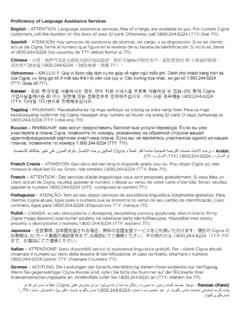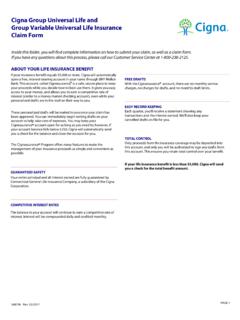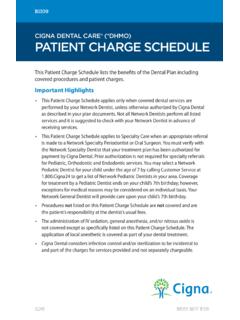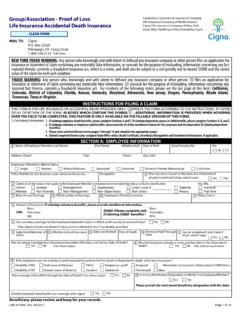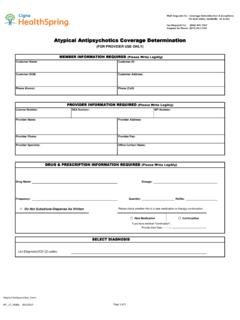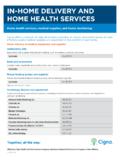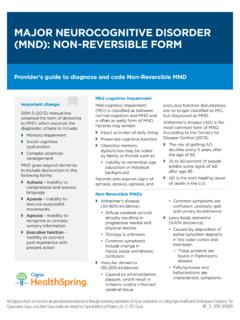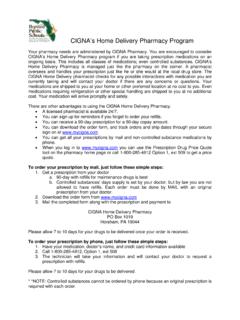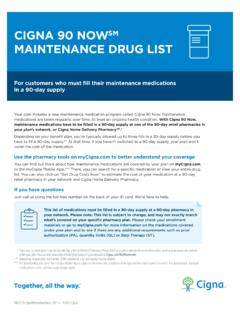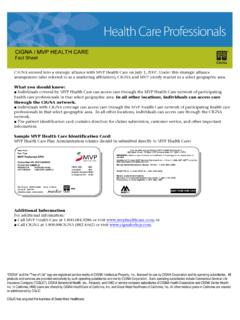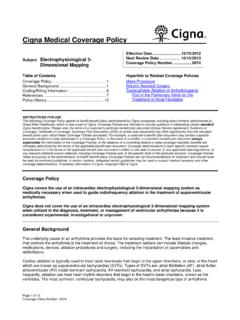Transcription of Cigna Centers of Excellence Program 2018 …
1 Cigna Centers of Excellence Program 2018 Methodology For Hospitals September 2017. Contents 2. Surgical Procedures and Medical Conditions .. 2. Patient Outcomes Data 3. Construction of the Cigna Hospital Quality 3. Complications 4. Mortality 5. CMS Hospital-Wide Readmission 7. CMS Readmission Rate Index for Pneumonia .. 7. Primary C-Section Delivery Rate Index .. 8. Leapfrog Hospital Safety Score Index .. 8. Early Elective Delivery Index .. 8. HCAHPS Summary Star Rating Index .. 8. CMS Healthcare-Associated Infections Index .. 9. Patient Outcomes: Hospital Quality Index Calculation and 9. Bariatric Centers of Excellence Evaluation .. 10. Cost-Efficiency: Hospital Cost-Efficiency Score Calculation .. 10. Cost-Efficiency: Hospital Cost-Efficiency Score Ranking .. 11. Market-level hospital comparisons .. 12. No Results Shown .. 12. Academic Teaching and Community Hospitals.
2 12. Updating Centers of Excellence and Hospital Value Tool 12. Process for Hospitals to Request Results .. 12. Process for Hospitals to Correct Errors or Request Reconsideration .. 12. Process to Provide Feedback .. 12. 13. APPENDIX 1: Data Sources for COE .. 13. APPENDIX 2: Condition/Procedure Population Specifications .. 14. APPENDIX 3: Conditions/Procedures with Hospital Quality Index Component Index Weights .. 23. All Cigna products and services are provided exclusively by or through operating subsidiaries of Cigna Corporation, including Cigna Health and Life Insurance Company, Connecticut General Life Insurance Company, Cigna Behavioral Health, Inc., and HMO or service company subsidiaries of Cigna Health Corporation. The Cigna name, logo, and other Cigna marks are owned by Cigna Intellectual Property, Inc. THN-2017-470. 2017 Cigna . Some content provided under license.
3 1. Introduction We annually evaluate hospital patient outcomes and cost-efficiency information through the Cigna Centers of Excellence (COE) Program . The 2018 hospital profiles will be available in the online provider directories on and , beginning January 1, 2018. The profiles contain information for up to 18 inpatient surgical procedures and medical conditions, 14 of which contribute to seven categories that combine related procedures, and are available for most Cigna - participating hospitals. A score of up to three stars (*) each for both patient outcomes and cost-efficiency measures can be received for each procedure and condition evaluated. Hospitals that attain either six or five stars (three stars for patient outcomes + two stars for cost-efficiency OR three stars for cost-efficiency + two stars for patient outcomes) receive the Cigna Center of Excellence designation for that procedure or condition.
4 Where condition categories are defined (Back surgery, Cancer conditions, Cardiac catheterization and angioplasty, Delivery, Heart surgery, Joint replacement, and Pulmonology medical), COE status is awarded for the condition category and not for the individual medical conditions or surgical procedures that comprise the category (see Table 1 for definitions). Approximately 80% of hospitals participating in our network (3,828 of 4,773), including those in third party vendor networks, met the defined volume criteria for evaluation of at least one surgical procedure or medical condition for 2018. Because the COE Program reflects only a partial assessment of quality and cost-efficiency for select hospitals, it should not be the sole basis for decision-making, and we encourage Cigna customers to consider all relevant factors and to speak with their treating physician when selecting a hospital.
5 Assessments under this Program are not utilized as the sole basis for performance based payments to Cigna -contracted hospitals. However, assessments may be a component of an overall pay for performance based payment methodology with some contracted hospitals. Surgical Procedures and Medical Conditions The 18 surgical procedures and medical conditions used for the 2018 hospital profiles listed in Table 1. are determined by volume, variability of outcome, and consumer interest. Table 1: 2018 Individual Level Assessments Surgical Procedures Individual level assessment - surgical procedures Bariatric surgery**. Colon surgery Gallbladder removal (Laparoscopic). Hysterectomy All Cigna products and services are provided exclusively by or through operating subsidiaries of Cigna Corporation, including Cigna Health and Life Insurance Company, Connecticut General Life Insurance Company, Cigna Behavioral Health, Inc.
6 , and HMO or service company subsidiaries of Cigna Health Corporation. The Cigna name, logo, and other Cigna marks are owned by Cigna Intellectual Property, Inc. THN-2017-470. 2017 Cigna . Some content provided under license. 2. 2018 Category Level Assessments - Surgical Procedures and Medical Conditions Category level assessment - surgical procedures and medical conditions Cardiac catheterization and Back surgery Cancer conditions Delivery Angioplasty Disc Surgery Mastectomy Cardiac Catheterization Cesarean Section**. Spinal Fusion Prostatectomy Angioplasty, with/without Vaginal delivery**. (Radical) Stent Heart surgery Joint replacement Pulmonology medical Coronary artery bypass Hip Chronic Obstructive graft (CABG) Knee Pulmonary Disorder Heart valve (COPD). replacement Pneumonia ** Surgical Procedures and Medical Conditions supplemented with Cigna claims data for states where MedPAR data is the only source to increase the volume of data for evaluation.
7 Patient Outcomes Data Sources We assess the quality of care treatment provided for 18 surgical procedures and medical conditions, 14 of which contribute to seven medical and surgical categories using measures of patient outcome derived from publicly available, hospital self-reported All-Payer and MedPAR data. MedPAR data is used where All-Payer data is not available. Two years of hospital data was used in the analysis. See Appendix 1 for state-specific data sources. Hospital admission volume for each surgical procedure or medical condition must meet a minimum of 100. incidences to be evaluated during the measurement period. Bariatric surgery must meet a minimum of 50. admissions. Hospital admission volume for category level evaluation must meet a minimum of 50. admissions per each condition within the category during the measurement period. Construction of the Cigna Hospital Quality Index The Cigna Hospital Quality Index is a composite index that we use to rank hospital performance for each of the COE eligible medical conditions and surgical procedures.
8 It is comprised of nine component indices that measure a dimension of hospital quality performance. Overall Hospital Quality Index scores are determined using three to six of the individual quality index components, depending on the specific condition or procedure being assessed (see Appendix 3). The component indices are as follows: Centers for Medicare & Medicaid (CMS) for: o Readmission Rate Index for Pneumonia o Hospital-wide readmission Index o Healthcare-Associated Infections (HAI) Index o Early Elective Delivery Index Agency for Healthcare Quality and Research (AHRQ) for: o Patient Safety Indicator (PSI) specifications used to calculate complication rates o Inpatient Quality Indicators (IQIs) used to calculate mortality rates o Primary cesarean-section delivery rates Hospital Consumer Assessment of Healthcare Providers & Systems (HCAHPS) Star Ratings Leapfrog Hospital Safety Score All Cigna products and services are provided exclusively by or through operating subsidiaries of Cigna Corporation, including Cigna Health and Life Insurance Company, Connecticut General Life Insurance Company, Cigna Behavioral Health, Inc.
9 , and HMO or service company subsidiaries of Cigna Health Corporation. The Cigna name, logo, and other Cigna marks are owned by Cigna Intellectual Property, Inc. THN-2017-470. 2017 Cigna . Some content provided under license. 3. The nine-component hospital quality indices are described in the following section of this document. Complications Index A Complications Index is designed to assess whether a hospital has a pattern of complications for patients who have one of the COE Program 's assessed surgical procedures or medical conditions. The index is constructed using Agency for Healthcare Research and Quality (AHRQ) Patient Safety Indicator (PSI) specifications. The complication index then contributes to the Cigna Hospital Quality Index for a given hospital and surgical procedure or medical condition along with other quality indices, each index receiving a designated weight.
10 The following steps are involved in the construction of the Complications Index: 1. Identify each patient during the data period that underwent an assessed COE Program surgical procedure or received treatment for an assessed COE Program medical condition at Hospital A. This population of patients is identified using specific MS-DRG and ICD-10 Procedure Code logic developed by WebMD (see Appendix 2). 2. For each procedure or condition-specific population of patients, determine whether each patient in that population was at risk for one or more of 18 medical or surgical complications as defined by AHRQ PSIs. If they are at risk, determine if the patient experienced that complication. At risk status for the complication is determined using the relevant PSI denominator specifications, while an occurrence of the complication is determined using the relevant PSI numerator specifications.


